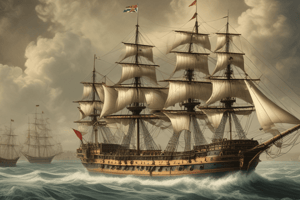Podcast
Questions and Answers
What monopoly was granted to the Dutch East India Company in 1608?
What monopoly was granted to the Dutch East India Company in 1608?
A 21-year monopoly on Dutch spice trade
What cargo did Dutch East India Company ships carry from Spanish mines in Peru?
What cargo did Dutch East India Company ships carry from Spanish mines in Peru?
Silver
What items did the Dutch East India Company trade with India and China?
What items did the Dutch East India Company trade with India and China?
Silk, textiles, and porcelain
In what year did the British East India Company’s first ship arrive in India?
In what year did the British East India Company’s first ship arrive in India?
Who granted the British East India Company its Royal Charter, and when?
Who granted the British East India Company its Royal Charter, and when?
Who was instructed by King James I to visit the Mughal Emperor Jahangir?
Who was instructed by King James I to visit the Mughal Emperor Jahangir?
What were the three primary locations where the British East India Company established trade centers?
What were the three primary locations where the British East India Company established trade centers?
What main factor contributed to the British East India Company’s immense wealth?
What main factor contributed to the British East India Company’s immense wealth?
What goods did the British East India Company trade from South India?
What goods did the British East India Company trade from South India?
Which event between 1756 and 1763 ensured British superiority over the French in Indian trade markets?
Which event between 1756 and 1763 ensured British superiority over the French in Indian trade markets?
Flashcards are hidden until you start studying
Study Notes
The Dutch East India Company
- Held a 21-year monopoly on the Dutch spice trade from 1608
- Shipped silver from Spanish mines in Peru and supplies for Dutch settlements in Asia
- Traded with India and China for luxury goods like silk, textiles, and porcelain
- Exchanged goods with European markets for products such as cotton, silk, and ceramics
The British East India Company
- Formed to claim a share of the East Indian spice trade
- Motivated by the immense wealth of ships returning from Eastern trade routes
- Granted a Royal Charter by Queen Elizabeth I on December 31, 1600
- Governed by a board of 24 directors and owned entirely by stockholders
- First ship arrived in India in 1608
King James I's Instructions
- Sent Sir Thomas Roe to meet Mughal Emperor Nuruddin Salim Jahangir in 1612
- Instructed Roe to negotiate a commercial treaty for exclusive rights to reside and establish factories in Surat and other areas
- Agreed to provide the Emperor with European goods and rarities in return
British Trade Centres
- Established trade centres in Madras, Bombay (now Mumbai), and Fort William in Calcutta (now Kolkata)
British Trade
- Traded in cotton, silk, indigo, saltpeter, and various spices from South India
- Established connections with the bankers of the Nawab of Bengal
The British East India Company's Wealth
- Accumulated immense wealth due to huge profits from trade
British-French Rivalry
- French entry into Indian trading markets in the 1740s sparked rivalry with the British
- British superiority over the French was established after the Seven Years War (1756-1763)
- The war effectively ended French ambitions, giving the British absolute superiority over their rivals
Studying That Suits You
Use AI to generate personalized quizzes and flashcards to suit your learning preferences.




